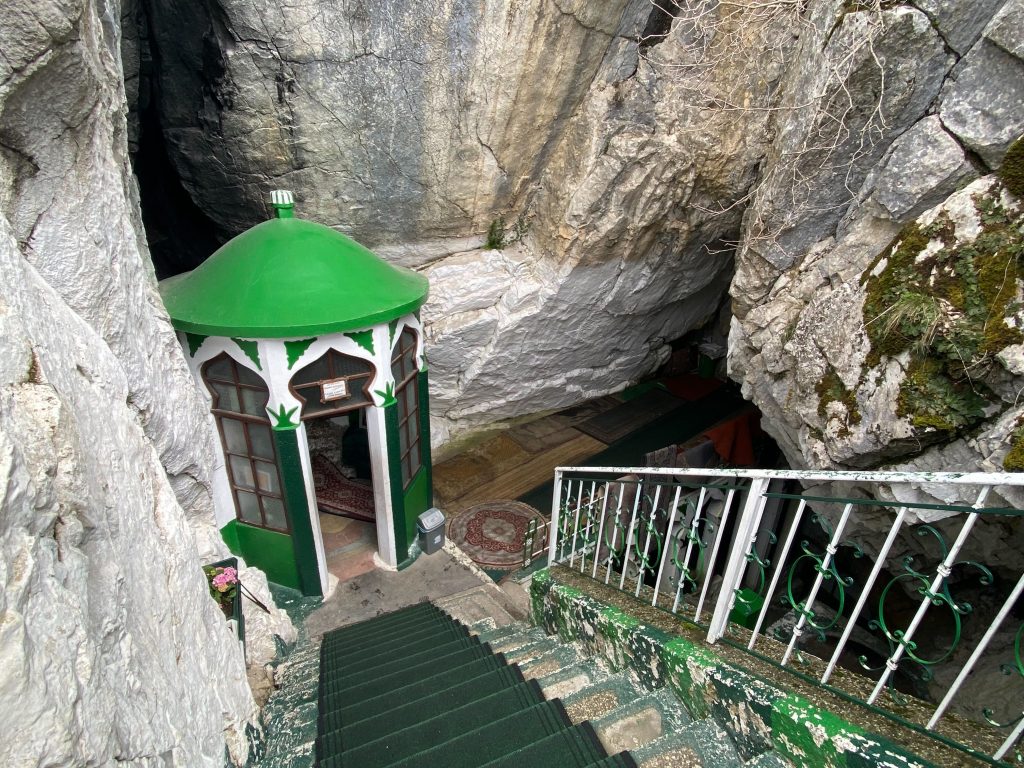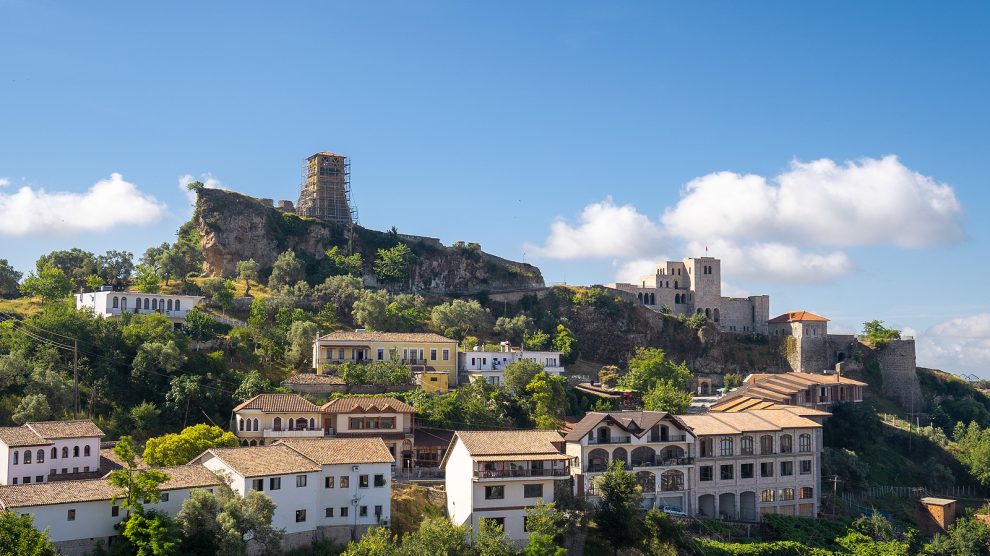With its castle, shrine, and mountain scenery, Krujë is the perfect day trip from Tirana for those who want to see Albanian countryside but don’t have the time to visit the south of the country.
It’s fair to say that Krujë, like Albania as a whole, loves George W. Bush. After 20 minutes of mountain switchbacks – passing the George W. Bush statue in Fushë-Krujë erected to commemorate his visit along the way – I got off the minibus outside of Krujë’s George W. Bush Bakery and Gelateria.
After grabbing a (frankly) less-than-edible hotdog, I continued onward into the touristic old bazaar towards the ruins of the 5th century castle looming over the town. It’s a wonder that the castle doesn’t also now carry the former US president’s name.
- How Albania ended World War II with a larger Jewish population than before it began
- Emerging Europe’s Book of the Year: Free, by Lea Ypi, a unique look at Albania in transition
- The way we travel is changing, and emerging Europe is well placed to take advantage
Around 30 kilometres north of Tirana, Krujë played a central role in the rebellion against the Ottoman Empire led by Skanderbeg—Albania’s national hero and leader of the League of Lezhë. Indeed, Skanderbeg is one of few locals whose popularity can top that of Bush. The League of Lezhë united the Albanian nobility against the Ottoman Empire and formed the first independent, unified Albanian state in the Middle Ages.
Krujë’s mountainside location is strategically advantageous, captured by Skanderbeg at the beginning of his rebellion in 1443. The castle town successfully repelled massive Ottoman sieges in 1450, 1466, and 1467. Skanderbeg alas died in 1468 and Krujë fell to a fourth Ottoman siege in 1478.
Krujë Castle is precariously perched above the hill town and offers grand views of the surrounding mountains, fields, and Adriatic Sea. A national history museum about Skanderbeg and ethnographic museum inside the castle walls allow visitors to learn about Albania’s rich cultural heritage while a restaurant at the foot of the tower allows you to leisurely take in the overwhelming scenery over an espresso.
Albanian hospitality
I had planned to return to the bazaar to spend more time chatting with storekeepers about the communist-era antiques they sold, but ran into a man working as a groundskeeper for the castle who had met some friends of mine when they previously visited Krujë. Minutes later I was in his car, snaking up uneven roads to the mountaintop Bektashi shrine of Sarı Saltık. How’s that for Albanian hospitality?
While Krujë is easily accessible by public transport from Tirana, the surrounding mountains are impenetrable without your own car or (plenty of) time for a hike. I had read about the shrine online but assumed I would be unable to visit it; my trip there was only possible because of the generosity of the groundskeeper, who was insistent I see the mountains while I was there.
As we parked at the very top of the mountain to which Krujë clings, I saw why he had been so determined to get me to the mountaintop. Krujë itself towers over Fushë-Krujë, but both looked tiny from the entrance to the shrine.
The shrine itself is in a cave below the parking lot, at the foot of long flight of stairs hewn from the cliffside. It contains a prayer area, an even smaller cave filled with candles lit by devotees, and one of several tombs throughout the Balkans alleged to belong to the 13th century Alevi dervish Sarı Saltık, who is venerated as a saint by Bektashi Muslims.
The Bektashi Order is headquartered in Tirana and has teqes across the Balkans. The shrine above Krujë is painted in the Order’s recognisable bright green and white colours, and outside the cave there is a building to host devotees visiting the shrine who need a place to stay.

Albania’s eccentricities
After climbing out of the shrine, we continued onwards into Qafshtama National Park. The brown of early April and the green of conifer groves made the light grey of the mountains’ sheer rock faces pop.
As we passed remnants of snow, we reached a curve in the road that allowed us to see through a gap in the peaks to glistening Bovilla Lake and—further away but clearly visible—the skyscrapers of Tirana. We prepared to turn around to return to Krujë, but there was one last surprise in store.
I have grown carnivorous plants for a hobby for a decade and a half, yet I had only seen these rare botanical wonders in nature a handful of times. But as we passed a roadside waterfall, the flowers of butterworts were unmistakable, and I yelled for my driver and host to stop the car.
Butterworts—also known as Pinguicula, Latin for ‘little greasy one’—trap gnats, springtails, and other small insects with their leaves’ small but sticky hairs. The insects’ touch and struggles triggers the secretion of mucilage and then digestive enzymes from the leaves’ glands. This dissolves the insects into a nutrient-rich soup, which the plant then absorbs and uses to compensate for the mineral-poor bogs in which it grows.

The Pinguicula hirtiflora growing in moss around the waterfall were already in full bloom, and their violet and white flowers injected rare colour into the early-spring landscape. As I inspected their rosettes, I found the unmistakable sight of the exoskeletons of otherwise-dissolved insect carcasses on their small, succulent leaves.
Albania’s charm lies in the density of its eccentricities—ancient castles, George W. Bush and communist paraphernalia, Sufi shrines, and carnivorous plants can all be found within minutes of each other. Many guides will recommend the Albanian Alps in the country’s far north or the old bazaar and fortress of Gjirokastër in the far south, but both are far enough from Tirana to make day trips exceedingly difficult or impossible.
So if you are just passing through and still want to experience the beauty of Albania’s mountains and charm of its villages, consider a visit to Krujë.
Unlike many news and information platforms, Emerging Europe is free to read, and always will be. There is no paywall here. We are independent, not affiliated with nor representing any political party or business organisation. We want the very best for emerging Europe, nothing more, nothing less. Your support will help us continue to spread the word about this amazing region.
You can contribute here. Thank you.



Add Comment